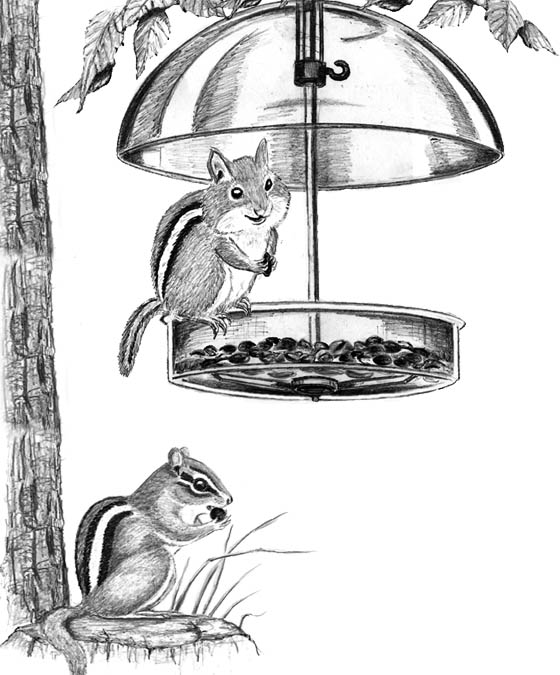
Dear Bird Folks,
A few years ago you sold me a squirrel-proof birdfeeder, which, much to my surprise, actually works. Now a new fiend has taken the squirrels’ place. Chipmunks are able to defeat the squirrel-proof feeder and are eating non-stop. I like chipmunks and wish them no harm, so my neighbor, Bob, suggested that I humanely trap the little guys and transplant them somewhere else. What do you think of that idea?
– Jim, Kingston, MA
Bad idea, Jim,
Next to your brother-in-law, neighbors give the worst advice. There is no way your neighbor is ever going to tell you anything that makes you look better than him. Whether you know it or not, Bob is your archenemy and he will always find a way to make you look bad. And in this case, his suggestions could get you hauled off to jail. No kidding.
Eastern Chipmunks have several distinctive characteristics. They have bushy tails, stripes and, of course, those adorable faces. While lots of creatures have bushy tails and are adorable, chipmunks have two signature features that separate them from most other animals: two expandable cheek pouches. Cheek pouches are a peculiar feature in nature and are basically only found in some rodents, monkeys and the late baseball coach, Don Zimmer. But unlike Zim, whose cheeks were used to hold chewing tobacco, the chipmunks’ cheeks are used for food transportation. (Even chipmunks know that chewing tobacco is a bad idea.)
While it seems as if your chipmunks are doing a lot of “non-stop” eating, in reality they are doing a lot of non-stop “storing.” Very little of what chipmunks take from a bird feeder is consumed on the spot. Most food is stuffed into their cheeks, taken to their underground burrows and will not be eaten until later. A chipmunk’s burrow composed of is a series of tunnels that lead to several chambers. One chamber is used for sleeping, others are for food storage and another is used as a bathroom. How about that? Chipmunks have the forethought and skill to build their own bathrooms. (They have to build their own bathrooms because, as we know, plumbers never show up.) Unlike gray squirrels, which are active year-round, chipmunks hibernate in the winter. However, the tiny chipmunks aren’t able to pack on extra fat. So, in order to survive the winter, chipmunks must wake up every few weeks for a snack. And what do they eat when they wake up? They eat nuts, seeds and birdseed (which hopefully was bought from me).
Now picture this: After a chipmunk spends months building a burrow and filling it with food, someone, based on his neighbor’s advice, catches the chipmunk and transports it to a woodlot on the edge of town. To us, all woodlots look the same, but to a chipmunk some areas are livable, while others not so much. But even if the new woodlot has what the chipmunk needs, there is no way the confused creature will have enough time to settle in, dig a new burrow and store an adequate food supply before winter sets in. In other words, it will be the end of the line for this chipmunk.
Back in the 1980s, before squirrel-proof feeders had been perfected, trapping and relocating squirrels was thought to be a humane solution. I remember driving to work one morning when the car in front of me suddenly stopped right in the middle of busy Rt. 6A. Instantly, the driver jumped out and sprinted around, opening all four doors in a matter of seconds. The driver then stepped back and everything got quiet. Then slowly from the backseat a grey squirrel emerged, looked around and headed for the nearest tree. As I burst out laughing, I could hear giggling coming from the other drivers who had also stopped. It was obvious that the driver was trying to relocate a squirrel and that the squirrel, which wasn’t in the mood to be relocated, had sprung itself from the trap. (Either that or the squirrel was trying out its new Uber account.)
While the above incident was funny (okay, hilarious), it was also dangerous. The driver could have lost control of the car. But equally as important, from the squirrel’s point of view, the driver’s attempt at humanely relocating the creature was actually inhumane. A recent study tells us that 97% of relocated squirrels don’t survive. Like the chipmunk, the squirrels either succumb to the elements, predators or starvation. And I don’t even want to talk about what happens to a nest filled with babies when some bonehead traps and takes away their mother.
Because of all the reasons I have just mentioned, trapping and transporting chipmunks, or any animal is not just a bad idea, it’s illegal. State law in Massachusetts prohibits trapping and relocating wild animals of any kind. (See, I told you – neighbor Bob was trying to set you up for a one-way ticket to the big house.)
Instead of traps, Jim, I suggest you just put up a baffle and your chipmunk problems will be over. I have lots of birdfeeders and they all sit on the tops of poles, which are protected by baffles. As a result, the chipmunks all eat off the ground and I don’t have to listen to lame advice from my neighbor. However, if you do decide to ignore what I say and want to relocate your chipmunks anyway, let me know when you are going to do it. I’d like to follow you in my car just in case something hilarious happens.